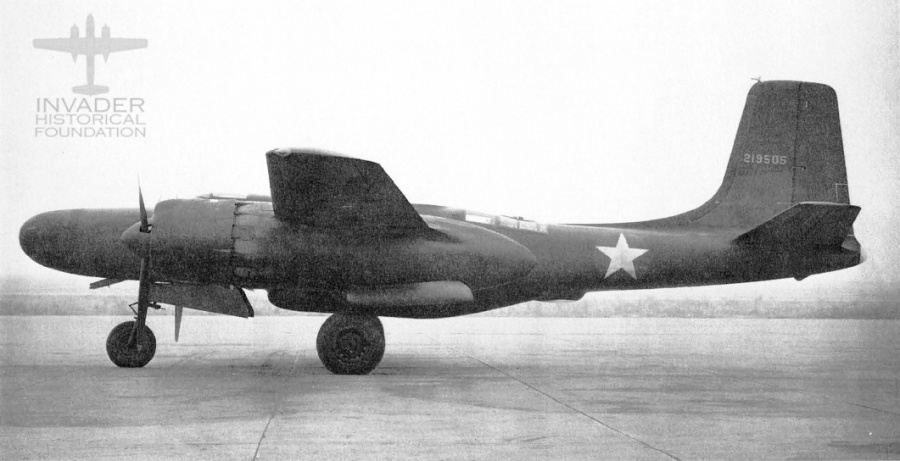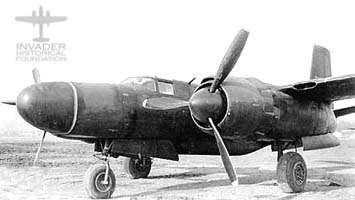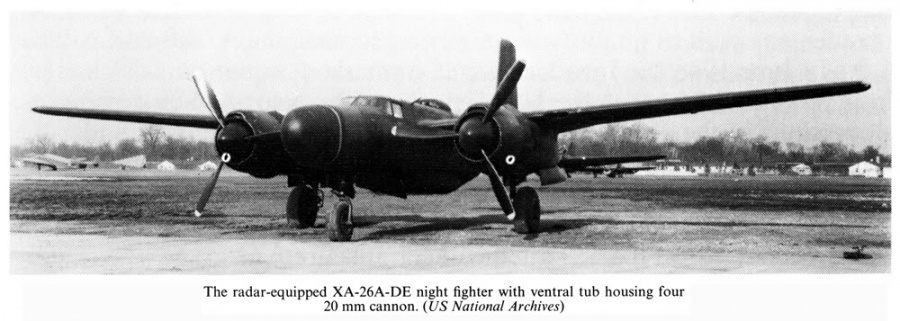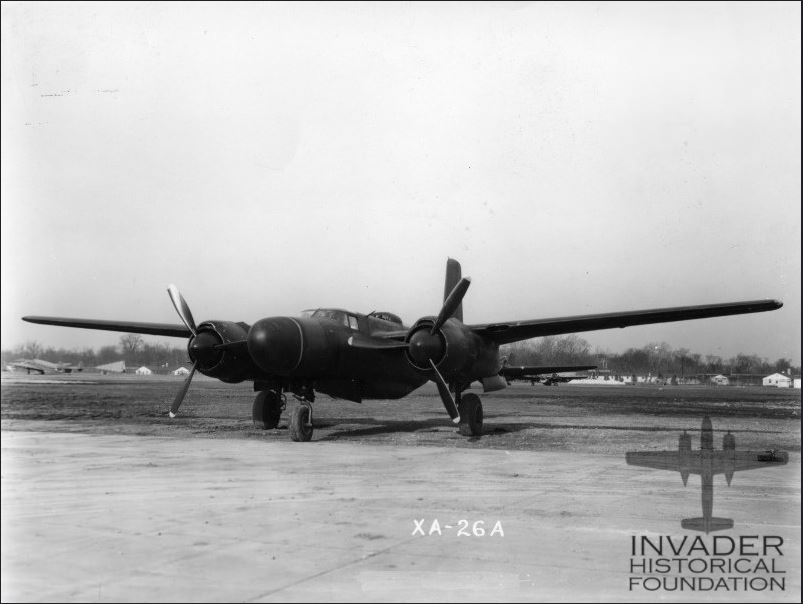41-19505
| XA-26A Invader | |||
|---|---|---|---|
| Builders: Douglas Aircraft Company | |||
| Operators: United States Air Force | |||
| Ordered 1941 | |||
| Number Built: 1 | |||
| First Built: 1942 | |||
| GENERAL CHARACTERISTICS | |||
| Type: Light Attack Bomber | |||
| Dry Weight: - | |||
| Wet Weight: - | |||
| Length: 51' 3" (15.24 m) | |||
| Height: 18' 6" (5.64 m) | |||
| Wingspan: 70' (21.34 m) | |||
| Wing Area: 540 Sq. Feet (50.17 m²) | |||
| Speed: - | |||
| Max Speed: - | |||
| Ceiling: 22,100 feet (6,700 m) | |||
| Powerplant: 2x Pratt & Whitney R-2800-27 | |||
| Horsepower: 2,000 | |||
| Fuel Capacity: - | |||
| Range: - | |||
| Crew: 2 | |||
| Passengers: 1 | |||
| ARMAMENT | |||
| Nose Guns: None | |||
| Dorsal Turret: None | |||
| Ventral Turret: None | |||
| Payload: 6,000 lbs | |||
See also: List of Invaders by Serial Number
This plane was the second working A-26 Prototype to be fully operational. In July of 1941 Douglas built a full-sized mock-up of the plane with dummy weapons to pitch to the Air Force. That initial display culminated in a contract for two operational prototypes - this plane, and 41-19504 (The XA-26). Later, the Air Force added a third prototype, the XA-26B (41-19588).
This plane was constructed with a solid nose but without the guns in either the nose or the turrets.
There is less information on this particular plane than there is on the XA-26.
This plane served as the prototype for a proposed "Night Fighter" variant. This variant had an elongated nose which housed enhanced radar suites. The plane also carried 4 20mm cannons in the belly in lieu of a traditional bomb bay. Ultimately this variant was decided that it was not needed as the US Army Air Force already had a dedicated night fighter in the P-61 Black Widow and this variant didn't offer anything substantive over that plane that would justify the cost. In the end it was deemed superfluous and this variant was not produced beyond the initial prototype. One observable difference between the prototype models and the production models was the "propeller spinner" - the cone-shaped piece in the middle of the propeller blades. The prototype units were equipped with this feature, but none of the production models had them.
Operational History
This plane was a prototype that was purpose-built for testing.
27 SEP 1943 - Received by USAF, flown to Mines Field, Inglewood, CA.
7 OCT 1943 - Assigned EX MATRRD, Wright AFB, OH.
22 MAR 1944 - Assigned to 4000th Base Unit, Wendover Air Force Base, UT.
24 APR 1944 - Assigned to 216th Base Unit, Wendover AFB, UT.
1 MAY 1944 - 4127th Base Unit, Wendover AFB, UT.
6 DEC 1944 - Departed Mather Field, CA.
6 DEC 1944 - Arrived at Long Beach, CA. Remained Over Night (RON)
8 DEC 1944 - Arrived at Eglin Air Force Base, FL.
10 DEC 1944 - Assigned to 610th Base Unit, Eglin AFB, FL.
29 JAN 1945 - Listed for salvage, scrapped.
Accidents
This plane does not appear in any accident databases.
Crew
I have no information on the flight or ground crew of this plane.
Disposition
Upon completion of the testing, this plane was written off by the Air Force.
Images
Luckily, being a prototype model, there are some images of this plane.
The XA-26A Protoype on the runway.


A closeup view of the 4 tub-mounted 20mm cannons. In examining the photo below it also appears that this plane initially had a different landing gear where the front landing gear is a straight bar with the tire on one side of it. Other photos above show the same type of gear that was fitted on the production models, which had a bar that came down and then bent so that the tire ended up directly under the gear trunk.

Sources
- Douglas A-26 Production List
- United States Air Force Accident Reports





